What Does Red Velvet Cake Taste Like? The Sweet Mystery Solved
Red velvet cake has intrigued dessert lovers for generations with its mysterious allure and vibrant appearance.
Bakers and food enthusiasts often wonder about the unique characteristics that set this crimson confection apart from other desserts.
The cake's origins trace back to southern United States traditions, where it became a beloved staple at gatherings and celebrations.
Subtle nuances distinguish red velvet from standard chocolate or vanilla cakes, creating a sensory experience that goes beyond simple flavor.
Its distinctive color and texture spark curiosity among those who have yet to sample this classic treat.
Restaurants and bakeries continue to reinvent this timeless dessert, making it a constant source of culinary fascination.
Your taste buds are in for a delightful journey as we unravel the delectable secrets of this iconic cake.
What Is Red Velvet Cake?
Red velvet cake is a special chocolate dessert covered in creamy white frosting. Soft cocoa colors this treat in shades ranging from deep red to rich brown.
Classic recipes rely on natural ingredients to create its signature color, not artificial dyes. Natural cocoa with high acid content gives this cake its unique reddish tone.
Southern bakers perfected this cake style, making it a beloved regional dessert. Vinegar and buttermilk work together to add a subtle tang that cuts through sweet frosting.
Cream cheese icing complements the cake's delicate texture, creating perfect balance between rich flavors. Small amounts of cocoa powder help develop deep color and mild chocolate notes.
Each slice promises a light, smooth texture that melts smoothly in your mouth. Southern kitchens celebrate this cake as more than just a dessert - it represents comfort and tradition.
Bakers carefully mix ingredients to create a cake with an incredibly soft, velvety crumb that feels luxurious with every bite.
Flavor of Red Velvet Cake
Red velvet cake stands out with its special taste.
Success comes from careful baking.
This cake blends vanilla and chocolate notes perfectly.
Buttermilk brings a tangy and salty kick to the mix.
Rich cream cheese frosting complements the cake's unique flavor profile.
Soft cake layers hold secrets of delightful taste combinations.
Red food coloring exists only for visual appeal, adding nothing to the actual flavor.
Each bite promises a balanced mix of sweet and subtle chocolate hints.
Bakers love this classic dessert for its complex yet simple charm.
Cream cheese frosting adds smooth creaminess that makes people want another slice.
Subtle ingredients work together to create something more than just an ordinary cake.
Chocolate undertones peek through the vanilla base, creating a memorable dessert experience.
Buttermilk helps keep the cake moist and adds depth to its overall taste.
Red velvet cake remains a beloved treat that continues to delight cake lovers everywhere.
Red Velvet Cake Texture
Red velvet cake sparks curiosity for many people wondering about its taste.
Most recipes create dense and moist cakes, which happens with many cake types.
Cream cheese frosting typically covers these cakes, making them sweet like carrot cake icing.
Vegan options will be available soon.
Cake layers show a deep red color with smooth, rich texture.
Cocoa powder gives the cake its special chocolate-like flavor.
Chocolate lovers appreciate how similar it feels to regular chocolate cake.
Rich ingredients contribute to its unique taste.
Red velvet stands as a classic dessert in American baking.
People recognize its signature reddish color and smooth texture.
Historically, bakers used beetroot juice to create the red shade.
During hard economic times like the Great Depression, this cake became a popular choice for many families.
Modern recipes now use red food dye instead of natural juice to achieve the bright color.
How to Keep Red Velvet Cake Moist
Keeping red velvet cake wet helps it stay super delicious. Small extra steps make your cake taste just as good days after baking.
Overcooked cakes quickly turn dry and crumbly. Check cake doneness in final baking moments using a toothpick.
Cake is ready when toothpick comes out clean from center.
Red velvet cake tastes best within 2 to 3 days of baking.
Is Red Velvet Cake Healthy?
Red velvet cake is a popular dessert, but is it healthy?
Get the facts before your next slice.
Cholesterol And Fat Levels
Red velvet cake carries a hefty amount of fat, sitting between 18 and 23 grams in each slice.
Dangerous health risks come from its saturated fat content, which reaches 4 grams, and includes 1 gram of trans fat.
Cholesterol levels climb to 73 milligrams per serving, which equals roughly one-fourth of medical experts' recommended 300 mg daily limit.
Calorie Content
Red velvet cake with cream cheese frosting carries between 400 and 453 calories for each 4-ounce slice.
Dieticians from diet experts suggest balanced meals usually range from 300 to 600 calories.
This means red velvet cake sits near meal calorie limits, so most dessert lovers would need to enjoy smaller portions to keep their eating balanced.
Protein And Carb Content
Red velvet cake contains 54 grams of carbs in a 4-ounce serving.
MedlinePlus recommends getting 40 to 60 percent of daily calories from carbohydrates on a 2,000-calorie diet.
Protein in this cake slice ranges from 4 to 5 grams.
Experts suggest consuming 50 to 65 grams of protein each day.
Vitamins And Minerals
A slice of red velvet cake gives you 8% of the iron you need each day, which is important for carrying oxygen through your body.
One serving also supplies 3% of your recommended daily vitamin A and calcium, helping support healthy vision and strong bones.
Possible Health Concerns
Red velvet cake challenges health-conscious sweet seekers with its nutrition profile.
Salt levels reach 330 to 333 milligrams in each slice, which covers roughly 20% of daily sodium recommendations set by heart health experts.
Standard guidelines suggest keeping sugar intake between 25.2 and 37.8 grams, but a small 4-ounce portion of this dessert packs 40 to 42 grams of sugar, surpassing suggested limits.
Is Red Velvet Healthier Than Chocolate Cake?
Chocolate cake and red velvet cake share nearly identical ingredients, making them similar in health impacts.
Color becomes the main difference, with most boxed cake mixes using red dye.
Researchers at the Center for Science in the Public Interest warn about potential risks from excessive red coloring.
People might experience hypersensitivity from consuming too much red dye, though such reactions remain rare.
Key points suggest that red velvet cake contains just a few teaspoons of red dye.
Moderate consumption poses little concern for most individuals.
Cake flavors sometimes hint at personal characteristics.
Vanilla and chocolate fans often seem more sophisticated, while lemon lovers come across as neat and polished.
Red velvet remains somewhat mysterious to many cake enthusiasts.
Curious minds might want to explore its rich background and unique story.
Is It Safe To Eat Red Velvet Cake?
Red velvet cake is a normal dessert that people can safely enjoy.
Velvet describes the smooth, silky feeling of cake layers, which are made with regular flour like other cake recipes.
No actual fabric goes into making this treat.
Someone with food allergies might face risks when eating the cake.
Dangerous reactions could happen if they are sensitive to specific ingredients used in the recipe.
Cake left out too long could become unsafe because of mold growth.
Spoiled food always poses health risks, which applies to any cake or baked good.
Cake remains a safe food choice for most people.
Each recipe might have slight differences, so individuals with known food allergies should carefully check ingredients before eating.
Safety depends on personal health conditions and ingredient awareness.

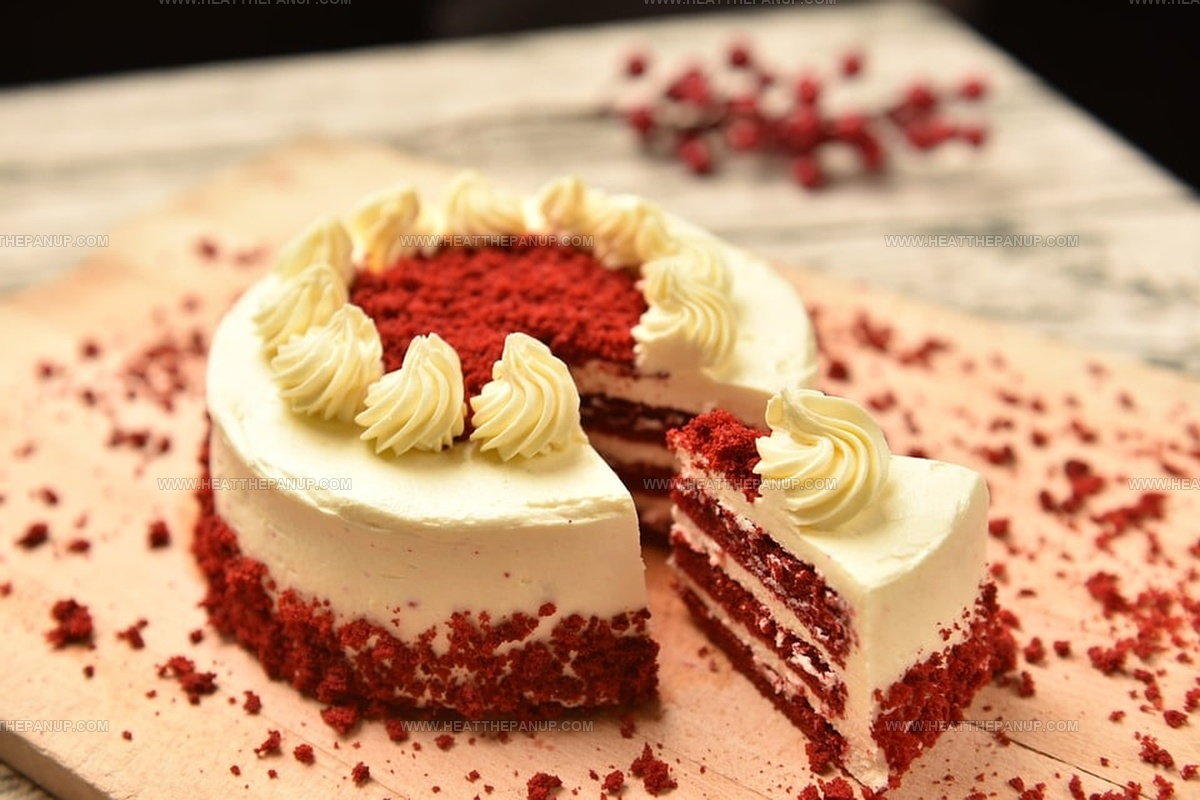
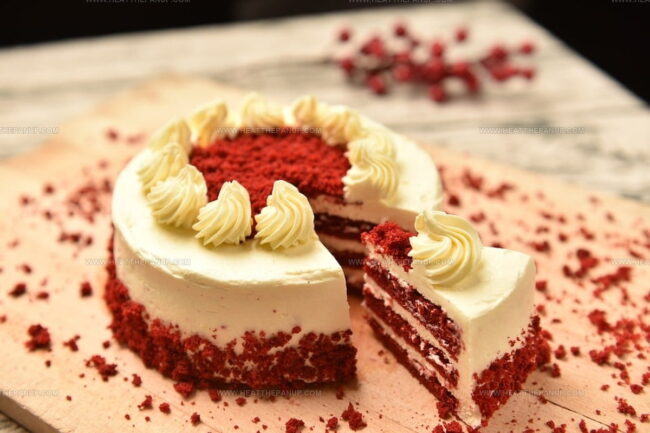
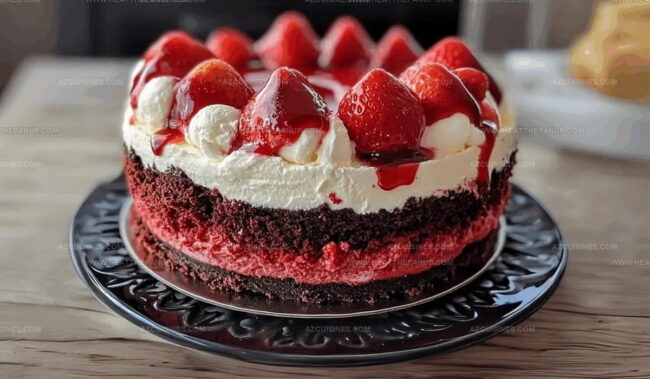
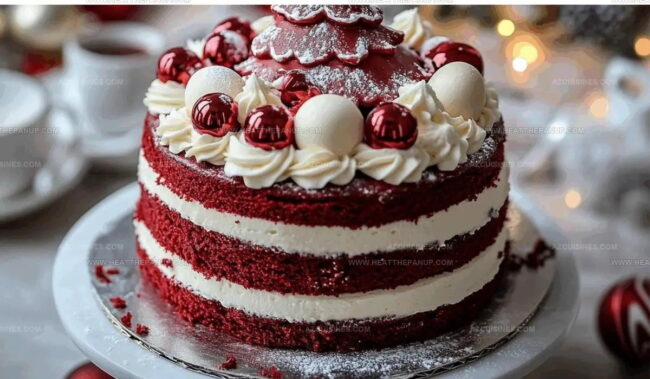
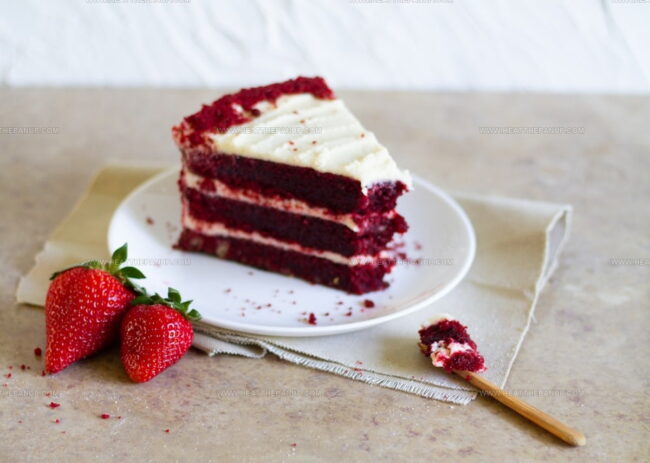
James Hambly
Founder & Recipe Creator
Expertise
Recipe Development, Culinary Education, Farm-to-Table Cooking, Southern Cuisine
Education
Asheville-Buncombe Technical Community College
Certificate in Culinary Arts
Focus: Hands-on training in professional cooking techniques, emphasizing farm-to-table practices and Southern cuisine.
The Chef’s Academy
Associate Degree in Culinary Arts
Focus: Comprehensive culinary education covering global cuisines, kitchen management, and food safety.
James grew up surrounded by the smells of cast-iron skillets and slow-cooked Southern meals in Asheville, North Carolina.
He sharpened his skills with a Certificate in Culinary Arts from Asheville-Buncombe Technical Community College, and later leveled up with an Associate Degree from The Chef’s Academy.
James’s philosophy is simple: the best meals don’t need fancy tricks, just fresh ingredients, a hot pan, and a little bit of heart. His favorite days are spent testing one-pan wonders, chasing bold flavors, and creating recipes that feel easy, even on a busy night.